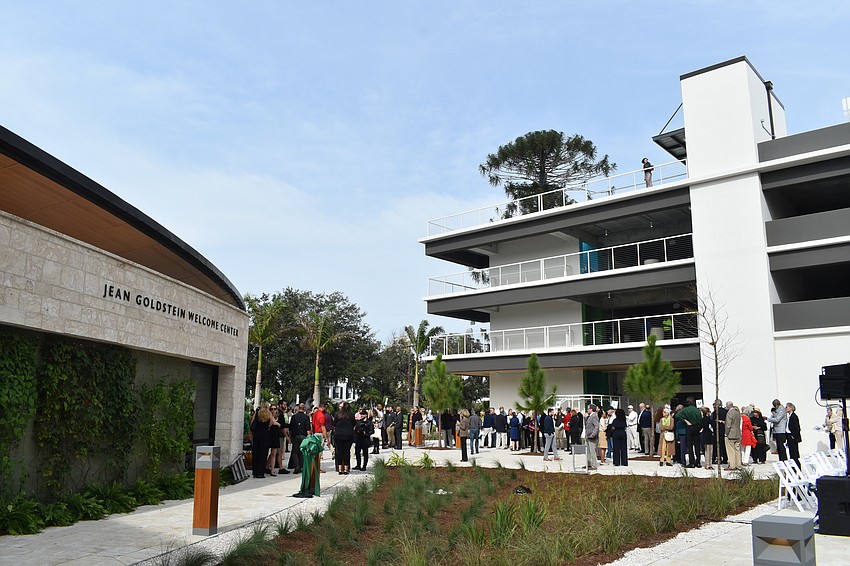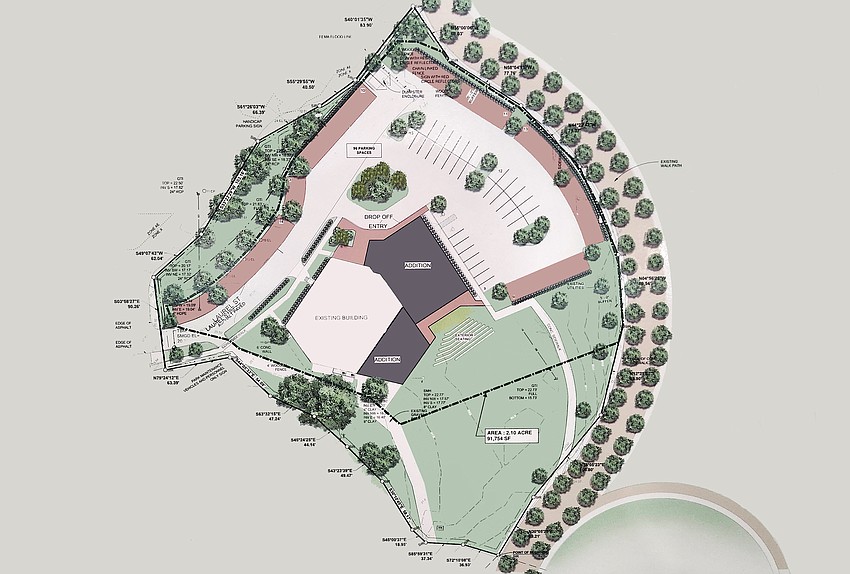- November 19, 2025
-
-
Loading

Loading

From a $17 million community theater to an upwards of $275 million performing arts center, members of the Greater Sarasota Chamber of Commerce heard from leaders of five local organizations working to bring nearly $700 million in cultural and scientific research development projects to the region.
Speakers at last Wednesday’s State of the Community luncheon included Marie Selby Botanical Gardens President and CEO Jennifer Rominiecki, Bay Park Conservancy Founding CEO AG Lafley, The Sarasota Players CEO William Skaggs, Sarasota Performing Arts Foundation Chairman Jim Travers and Mote Marine Laboratory and Aquarium President and CEO Michael Crosby.
Each spoke about their respective projects and how they add to the cultural and economic vitality of the community.
Rominiecki recently oversaw the completion of the first phase of the Selby Gardens master plan, a $51 million expansion that included a new parking structure called the Living Energy Access Facility, a new restaurant and gift shop, welcome center, research and office facilities and the conversion of the terminus of Palm Avenue from a street into a pedestrian walkway. The LEAF nearly doubled parking from 270 spaces to 450, and currently under installation is a solar array atop the structure that will make it the first net-positive energy botanical gardens in the world.

“Many people never realized Selby Gardens was privately owned, and at any time during our 50-year history the Board of Trustees could have sold parcels for high-density development. We never want that to happen,” Rominiecki said. “Probably one of the best aspects of the plan is codifying it as a botanical gardens."
Despite all the growth, “The gardens we all know and love really remain unchanged,” she said.
To pay for the master plan work, a capital campaign has raised $57.1 million toward its $92 million goal, which includes $20 million for an endowment and operations.
With the first of multiple phases of The Bay open for just over a year drawing 337,000 visitors, Lafley said late-stage planning for Phase 2 is underway. That round of work will focus on the south side the 10th Street boat launch, redevelopment and enhancements along Tamiami Trail including a rehab of Sarasota Municipal Auditorium, building a resilient shoreline along the bayfront and construction of the Sunset Pier.
As founding CEO of the Bay Park Conservancy, Lafley has helped lead a capital campaign that has raised more than $45 million toward its $100 million share of the estimated $200 million to build out all phases of the 53-acre, city-owned site over the next decade.
The agreement between local government and BPC is for the city and county to pay half of the cost via a tax increment finance district immediately surrounding the park, and the BPC half through grants and philanthropy. A TIF is a value capture revenue tool that uses taxes on future gains in real estate values to pay for infrastructure improvements.
“That TIF district is going to serve the Sarasota community extremely well,” Lafley said. “It basically sets aside the increment from new commercial and residential construction. We thought maybe it would generate $150 million to $200 million of value that could be reinvested in that 53 acres and, if the city chooses, a new performing arts center. The current estimate is $350 million.”
The TIF lasts 29 years, and a TIF-backed bond taken by the city has already funded $48 million of the $65 million Phase 2, with the balance covered by the BPC.
As Lafley mentioned, some of the TIF revenue can be applied toward a new performing arts center, which would be located within The Bay near Tamiami Trail at 10th Street on the opposite corner of the parking lot from the Van Wezel Performing Arts Hall.
The architecture firm Renzo Piano Building Workshop of Genoa, Italy, has been selected to design the new building, and with new CEO Tania Castroverde Moskalenko joining the foundation in February, the capital campaign for the SPAC will soon shift into high gear. Like The Bay, construction of the SPAC is proposed to be equally funded by an equal public-private partnership.
“We had 43 of the greatest architects in the world submit, which tells you something about Sarasota and the project,” Travers said. “We winnowed that down to three final firms and we chose Renzo Piano, who is a world-class architect second to none.”
Travers said, like the Van Wezel, the proposed facility will serve generations five decades or more into the future.
“This is transformational and multi-generational in terms of what we're trying to do," Travers said. "Obviously, it's got to be community driven and we're going to be doing a lot to get our messaging out from this point forward with Tania coming on board to make sure the community is engaged.”
Formerly known as The Players Centre for Performing Arts, the city’s first cultural organization and community theater was founded in 1929. It is currently in negotiations with the city on its plans to renovate and expand Payne Park Auditorium for its new permanent home, a $17 million project that is intended to also accommodate several community performing arts organizations that need smaller venues.
Althrough its subsidiary The Stage at Payne Park, The Players has seeded a $17 million capital campaign with $4 million.

“It's more than just the project. We want to provide a sense of place, a place to call home,” Skaggs said. "We will be looking to the community to assist us in many different ways in building this out because these other organizations, for many of them, it's not just about looking for somewhere to perform, it’s about a sense of place.”
Expanding the building to 24,000 square feet will allow for a main theater space with flexible seating for multiple configurations. It can also serve as event space. The Players has entered into a 10-year, renewable lease with the city, and The Players and The Stage at Payne Park are responsible for all improvement and expansion costs.
“This will add to the opportunities within this community for performances, luncheons, weddings, bar mitzvahs, whatever it may be," Skaggs said. "And after all that, having it sitting in a city park so you’ve got the outside and you’ve got what we love so much about this community.”
With the new $132 million MOTE Science Education Aquarium taking ship shape, literally, next to Nathan Benderson Park, Crosby said the project is more than just the new aquarium, it’s also about the opportunity to expand its science and research operations at its current location on City Island.
At 110,000 square feet, the Mote SEA double its the size of the current aquarium. Its highly visible, more convenient location along I-75, combined with its unique ark-shaped architecture, is expected to capture more visitors and better serve schools throughout the region.
The annual economic impact of some 700,000 anticipated visitors per year, Crosby said, is estimated at about $28 million. A study commissioned by Mote in 2016, he added, indicated the total economic impact of Mote at more than $89 million. That is largely due to a staff of more than 300, including 45 Ph.D.-level scientists overseeing 27 research programs.
“The science is the real jewel behind it all,” Crosby said. “We have truly grown into a global powerhouse of marine research and STEM education, and we wouldn't be that if it wasn't for this community. This is such an incredibly giving, supporting community for so many organizations, and you've just heard from several of those that would not exist if not for the philanthropic vision that many of the residents who are here in this region have.”
The Mote SEA remains on schedule, Crosby said, for a winter 2024 opening.